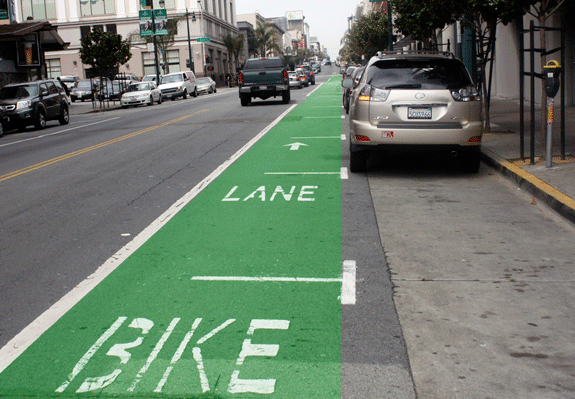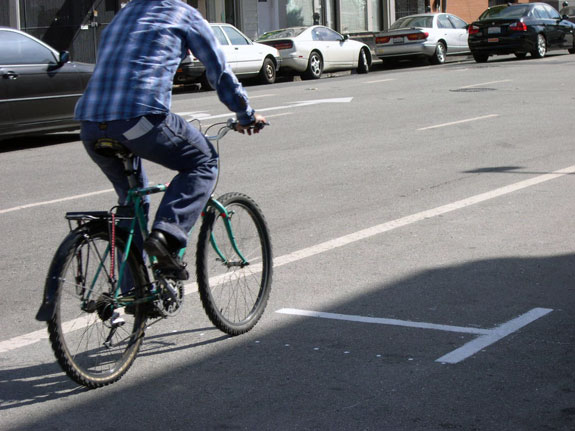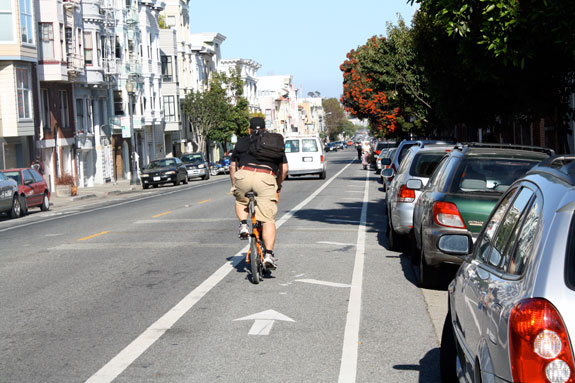The door zone is one of the biggest urban threats to bicyclists. Conventional bike lanes that squeeze bicyclists between the door zone and automobile traffic leave little room for error, but the San Francisco Municipal Transportation Agency is piloting a series of projects designed to encourage bicyclists to steer clear of the door zone.
On sections of Polk Street, pictured above (and yes, we added the green but do hope to see green bike lanes on Polk Street some day soon!), the SFMTA has painted in a batch of T's in the bike lanes that are supposed to guide bicyclists away from the door zone. While the treatment seems to be an improvement over typical door zone lanes, it also highlights how little street width is available for cyclists to ride safely.
I asked our graphics designer Carly Clark to do a little photoshopping to illustrate how much real space bicyclists have if you consider the door zone. If you take a standard five foot bike lane, like the one above, and factor in the door zone, you realize bicyclists are only given a sliver of a space that is about one to two feet wide, depending on the width of the lane, and the size of a car door.
According to the SFMTA, dooring is the second most common form of injury collision involving cyclists, behind unsafe speed, though the San Francisco Bicycle Coalition (SFBC) points out that dooring is the highest injury collision type caused by motorists or their passengers.
The SFMTA has installed the T treatments on Polk between Post and Golden Gate and in the bike lanes on Howard Street between 5th and 7th. So far, according to the agency, they seem to be effective:
We’ve done before/after studies on both Polk and Howard where we were able to reduce the number of cyclists riding in the door zone. On Howard Street (study conducted 2006) the average distance from the curb where cyclists rode increased from 10.3 feet to 10.9 feet, with 24% riding in the door zone before and 10% after. On Polk Street (study conducted 2009-10) the average distance from the curb where cyclists rode increased from 10 feet to 10.4 feet, with 41% riding in the door zone before and 30% after.
The SFMTA is also experimenting with a cross-hatch design to keep bicyclists out of the door zone on 17th Street between Dolores and Guerrero streets.
The T treatment is becoming common in more cities, and is also highlighted in the Urban Bikeway Design Guide, said David Vega-Barachowitz, the sustainable initiatives program manager for the National Association of City Transportation Officials.
Designing Better Bike Lanes
"I think that cities are really embracing the general principle that you shouldn't put a bike lane right in the door zone," he said.
NACTO's recently released Urban Bikeway Design Guide encourages left-side bike lanes on one-way streets and buffered bike lanes to "provide greater shy distance between motor vehicles and bicycles." The minimum requirements are outlined in the guide, said Vega-Barachowitz, but creating a buffer zone between moving and parked cars is what's recommended.
When placing a bike lane next to a parking lane, the guide also encourages a 4-inch solid line between both lanes, with a 14.5-foot distance between the edge of the bike lane and the curb. A 2006 study by the SFMTA found that placing the right stripe of the bike lane farther from the curb was more effective at keeping bicyclists out of the door zone than it was at keeping cars closer to the curb.
Some cities have opted for sharrows on some streets instead of bike lanes to keep bicyclists out of the door zone, but Vega-Barachowitz noted that a bike lane has a greater calming effect on a street than just shared lane markings. A street with sharrows may also not meet the 8 to 80-year-old standard being pushed by bike advocates. More cities are now recognizing, however, that door zone bike lanes are not good engineering.
Long Beach and Salt Lake City recently began experimenting with hybrid sharrow lanes. Green paint and sharrows demarcate the space for bicyclists while improving their lateral position in a lane that is also shared with auto traffic.
"Those kinds of solutions are going to emerge in a more sophisticated way over the next five years as people use color more frequently and understand riders' habits when they're in consistent streams," said Vega-Barachowitz.
Education
Of course, staying out of the door zone is not only about design, but about educating bicyclists "to make sure that their lateral positioning in the bike lane is outside the door zone," said Vega-Barachowitz.
"In general, the designer should design it so that bicyclists will use it that way, but you know, in a street in Boston where there's really not that much right of way to begin with, you're going to have people that aren't necessarily that comfortable riding in the road that are going to be riding in the door zone because they're trying to move as far away from cars as possible."
Bert Hill, a certified cycling instructor who teaches the San Francisco Bicycle Coalition's popular Urban Cycling Workshops, advocates staying four feet away from car doors and said most students are not aware of the door zone.
"What they do understand after a little while is the biggest danger in the door zone is not hitting the door with your bike. It's actually being on the outer edge and having your handlebar encounter the door edge," he said. "What happens is it pulls your front wheel hard to the right and when you do that your bike frame moves to the left and so you're almost always thrown into traffic."
And that, according to Hill, is what has lead to many dooring fatalities. "That's why we advocate the full four feet, because you can be outside of the door itself, but if just the edge of your handlebar catches it, that does it."
Hill said if he had a choice between door zone bike lanes and sharrows, he would prefer sharrows. And while he's supportive of the SFMTA's door zone treatments, he's not sure that bicyclists understand what they are.
"I think it's a really good idea where you don't have sharrows," said Hill. "But I think the only problem with it is that nobody understands that very well. I think it's a good thing to know if you're a bicyclist, but in my opinion it's not as good as sharrows at telling motorists that the bicyclist is expected to be there."







